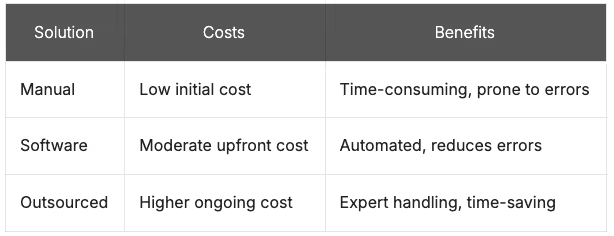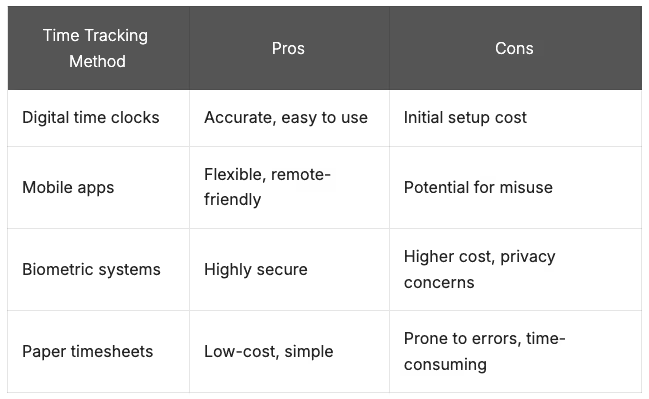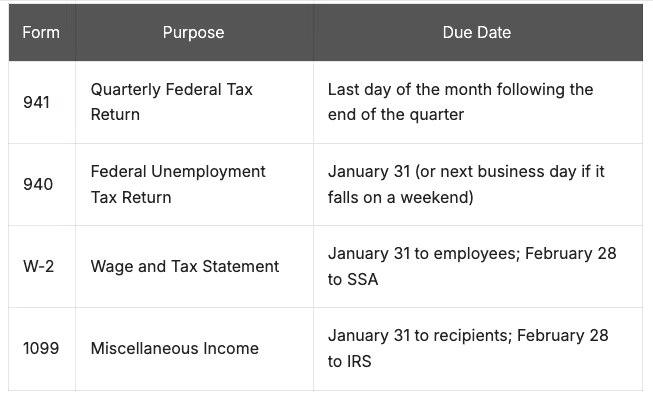Does the word “payday” make you feel more stressed than excited? You’re not alone. For many small business owners, payroll is that one task that always comes with a side of headaches—tax forms, compliance worries, and the pressure to get everything right. But what if you could finally make payday drama-free?
What if payroll runs like clockwork, no headaches, just your employees getting paid accurately and on time. Sounds good, right? Well, it’s totally doable. In this guide, we’ll cut through the payroll confusion and show you how to simplify your process, stay compliant, and keep your team happy.
Understanding Payroll Basics
A. Defining payroll and its importance
Payroll is the process of compensating employees for their work, including calculating wages, withholding taxes, and distributing payments. For small businesses, effective payroll management is crucial for several reasons:
- Employee satisfaction and retention
- Legal compliance
- Financial accuracy and planning
- Business reputation
B. Legal requirements for small business payroll
Small businesses must adhere to various legal requirements when managing payroll:
- Employee classification (W-2 vs. 1099)
- Minimum wage laws
- Overtime regulations
- Tax withholding and reporting
- Record-keeping obligations
C. Key components of payroll management
Effective payroll management involves several key components:
- Time tracking
- Wage calculation
- Tax withholding and reporting
- Benefits administration
- Payroll processing and distribution
- Record-keeping and reporting
By understanding these payroll basics, small business owners can lay a solid foundation for managing their payroll effectively and efficiently. Next, we'll explore how to choose the right payroll system for your small business needs.
Choosing the Right Payroll System
Now that we understand the basics of payroll, let's explore how to choose the right payroll system for your small business. Selecting an appropriate system is crucial for efficient payroll management and can save you time and money in the long run.
A. Cost-benefit analysis of different solutions
When considering payroll solutions, it's essential to weigh the costs against the benefits. Here's a comparison of different options:

B. Factors to consider when selecting a system
Several factors should influence your decision when choosing a payroll system:
- Business size and growth projections
- Budget constraints
- Complexity of payroll needs (e.g., multiple pay rates, benefits)
- Time available for payroll management
- Integration with existing accounting software
D. Manual vs. automated payroll methods
While manual payroll methods may seem cost-effective initially, automated systems often provide better value in the long run:
- Manual methods require more time and are prone to errors
- Automated systems reduce mistakes, save time, and often include compliance updates
With this understanding of payroll systems, you're better equipped to make an informed decision. Next, we'll delve into setting up your chosen payroll process effectively.
Setting Up Your Payroll Process
Now that you've chosen the right payroll system for your small business, it's time to set up your payroll process. This crucial step will ensure smooth operations and help you manage payroll effectively.
A. Creating a system for time tracking
Implementing an efficient time tracking system is essential for accurate payroll management. Consider the following options:
- Digital time clocks
- Mobile apps
- Biometric systems
- Paper timesheets

B. Establishing payroll policies
Clearly defined payroll policies help prevent misunderstandings and ensure consistency. Your policies should cover:
- Overtime rules
- Paid time off
- Sick leave
- Holiday pay
- Bonuses and commissions
C. Determining pay periods and schedules
Choose a pay schedule that works best for your business and employees:
- Weekly
- Bi-weekly
- Semi-monthly
- Monthly
Consider factors such as cash flow, employee preferences, and industry standards when making your decision.
D. Gathering employee information
Collect all necessary information from your employees to set up their payroll records:
- Personal details (name, address, contact information)
- Social Security number
- Tax withholding forms (W-4)
- Direct deposit information
- Emergency contact details
With these elements in place, you'll have a solid foundation for managing payroll in your small business. Next, we'll delve into the intricacies of calculating wages and deductions to ensure accurate payment processing.
Calculating Wages and Deductions
When managing payroll for a small business, accurately calculating wages and deductions is crucial. This process involves several key components that ensure employees are paid correctly and all necessary deductions are accounted for.
Handling employee benefits and deductions
Employee benefits and deductions can significantly impact take-home pay. Here's a breakdown of common items:
- Health insurance premiums
- Retirement plan contributions (e.g., 401(k))
- Life insurance premiums
- Flexible spending account (FSA) contributions
- Union dues
- Garnishments (if applicable)
Ensuring accurate record-keeping
Accurate record-keeping is essential for compliance and transparency. Maintain detailed records of:
- Hours worked
- Pay rates
- Overtime hours
- Vacation and sick time
- Bonuses and commissions
Managing tax withholdings
Proper tax withholding is crucial to avoid penalties and ensure employees' tax obligations are met. Consider the following:

Calculating overtime and bonuses
Overtime and bonuses require special attention:
- Overtime: Typically 1.5 times regular pay rate for hours worked over 40 per week
- Bonuses: May be subject to different tax withholding rates
Understanding different types of compensation
Small businesses may offer various compensation types:
- Hourly wages
- Salaries
- Commission-based pay
- Piece-rate pay
- Tipped wages
Each type has unique calculation requirements and potential tax implications.
Now that we've covered the intricacies of calculating wages and deductions, let's explore how to stay compliant with payroll taxes, which is crucial for avoiding costly penalties and legal issues.
Staying Compliant with Payroll Taxes
Now that you've set up your payroll process and calculated wages, it's crucial to ensure compliance with payroll taxes. This aspect of payroll management can be complex, but with the right strategies and knowledge, you can navigate it successfully.
Strategies for Avoiding Common Tax Mistakes
To maintain compliance and avoid costly errors, consider these strategies:
- Double-check all calculations
- Keep accurate and up-to-date records
- Stay informed about tax law changes
- Use reliable payroll software
- Consult with a tax professional when needed
Filing Deadlines and Forms
Staying on top of deadlines is crucial for small business payroll management. Here's a quick reference table for key federal payroll tax forms and their due dates:

State and Local Tax Requirements
In addition to federal obligations, be aware of state and local tax requirements, which can vary significantly:
- Income tax withholding
- Unemployment insurance
- Workers' compensation
- Local payroll taxes (in some jurisdictions)
Research your specific location's requirements or consult with a local tax expert to ensure full compliance.
Federal Tax Obligations
Small businesses must fulfill several federal tax obligations:
- Income tax withholding
- Social Security and Medicare taxes (FICA)
- Federal Unemployment Tax (FUTA)
- Self-employment tax (for business owners)
Understanding and meeting these obligations is essential for proper payroll management and avoiding penalties.
With these tax compliance strategies in place, you'll be better equipped to manage payroll for your small business effectively. Next, we'll explore ways to streamline your payroll operations for increased efficiency.
Streamlining Payroll Operations
Now that we've covered the basics of payroll management and compliance, let's focus on ways to streamline your payroll operations. Implementing efficient processes can save time, reduce errors, and improve overall productivity for your small business.
A. Training employees on self-service options
Empowering your employees with self-service options can significantly reduce the administrative burden on your payroll team. Consider implementing a user-friendly portal where employees can:
- Access pay stubs and W-2 forms
- Update personal information
- Submit time-off requests
- View and manage benefits

B. Integrating payroll with accounting systems
Seamless integration between your payroll and accounting systems can streamline financial reporting and reduce manual data entry. This integration offers several advantages:
- Automatic syncing of payroll data with your general ledger
- Real-time financial reporting
- Simplified tax preparation and filing
C. Automating tax payments and filings
Automating tax-related tasks can help ensure timely payments and reduce the risk of penalties. Consider using payroll software that offers:
- Automatic calculation of federal, state, and local taxes
- Scheduled electronic tax payments
- Generation and filing of required tax forms
D. Implementing direct deposit
Direct deposit is a win-win for both employers and employees. Benefits include:
- Reduced processing time and costs
- Increased security (no lost or stolen checks)
- Improved employee satisfaction
- Environmentally friendly (paperless option)
By implementing these streamlining strategies, you can create a more efficient payroll process for your small business. Next, we'll address common payroll issues and how to resolve them effectively.
Troubleshooting Common Payroll Issues
As we delve into the final aspect of managing payroll for small businesses, it's crucial to address common issues that may arise. By understanding these challenges and knowing how to tackle them, you can ensure a smooth payroll process for your organization.
Dealing with payroll fraud and security concerns
Payroll fraud can be a significant threat to small businesses. To mitigate this risk:
- Implement strict access controls to payroll systems
- Regularly audit payroll records
- Use automated systems to flag suspicious activities

Handling payroll during employee turnover
Employee turnover can complicate payroll management. To streamline this process:
- Create a standardized offboarding checklist
- Accurately calculate final paychecks, including any accrued benefits
- Update payroll systems promptly to reflect changes
Managing late or missed payments
Late or missed payments can damage employee trust and morale. To address this issue:
- Set up automatic payment systems
- Maintain a contingency fund for emergencies
- Communicate transparently with employees if delays occur
Addressing payroll errors promptly
When errors occur, swift action is crucial. Follow these steps:
- Identify the error and its cause
- Communicate with affected employees immediately
- Make necessary corrections in the next pay cycle
- Review processes to prevent future occurrences
By addressing these common payroll issues proactively, small businesses can maintain a reliable and efficient payroll system, fostering trust and satisfaction among employees.
Managing payroll effectively is crucial for the success of small businesses. By understanding payroll basics, choosing the right system, and setting up a streamlined process, you can ensure accurate wage calculations and timely payments to your employees. Staying compliant with payroll taxes and addressing common issues promptly will help you avoid legal complications and maintain a positive work environment.
As you implement these strategies, remember that payroll management is an ongoing process that requires attention to detail and continuous improvement. Regularly review your payroll practices, stay informed about changes in tax laws, and consider seeking professional advice when needed. With a well-managed payroll system in place, you can focus on growing your business while keeping your employees satisfied and motivated.































%20(2).avif)















